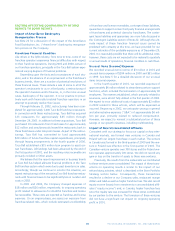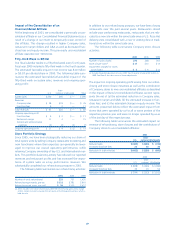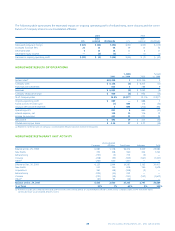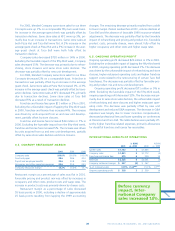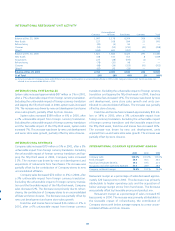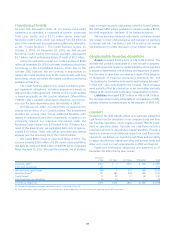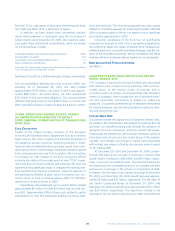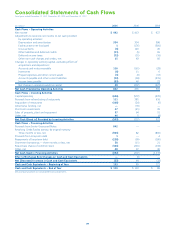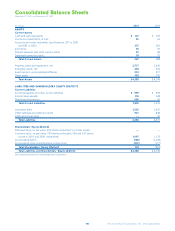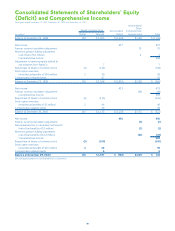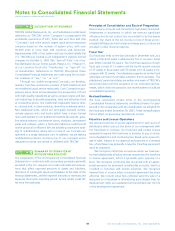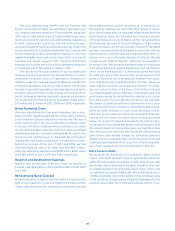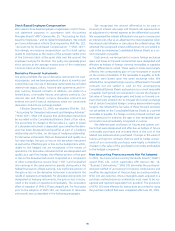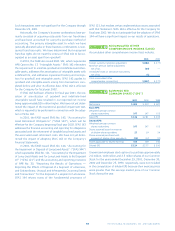Pizza Hut 2001 Annual Report Download - page 38
Download and view the complete annual report
Please find page 38 of the 2001 Pizza Hut annual report below. You can navigate through the pages in the report by either clicking on the pages listed below, or by using the keyword search tool below to find specific information within the annual report.36 TRICON GLOBAL RESTAURANTS, INC. AND SUBSIDIARIES
See Note 12 for a discussion of short-term borrowings and long-
term debt and Note 13 for a discussion of leases.
In addition, we have certain other commercial commit-
ments where payment is contingent upon the occurrence of
certain events. As of December 29, 2001, the maximum expo-
sure under these commercial commitments, which are shown
on a nominal basis, include:
Contingent liabilities associated with lease assignments $ 435
Standby letters of credit(a) 204
Guarantees of unconsolidated affiliates’ debt 12
Other commercial commitments 44
(a) Includes $32 million related to guarantees of financial arrangements of franchisees,
which are supported by stand-by letters of credit.
See Notes 12 and 22 for a further discussion of these commitments.
Our unconsolidated affiliates also have long-term debt out-
standing. As of December 29, 2001 this debt totaled
approximately $134 million, our share of which was approxi-
mately $68 million. As noted above, we have guaranteed
$12 million of this total debt obligation. Our unconsolidated
affiliates had total assets of over $900 million as of year-end
2001 and total revenues of approximately $1.6 billion in 2001.
OTHER SIGNIFICANT KNOWN EVENTS, TRENDS
OR UNCERTAINTIES EXPECTED TO IMPACT
2002 ONGOING OPERATING PROFIT COMPARISONS
WITH 2001
Euro Conversion
Twelve of the fifteen member countries of the European
Economic and Monetary Union adopted the Euro as a common
legal currency. We have Company and franchise businesses in
the adopting member countries. Beginning January 1, 2002,
new Euro-denominated bills and coins were issued, and a tran-
sition period of two months began. During the transition period
local currencies were removed from circulation. We took actions
to mitigate our risks related to the Euro conversion efforts
including the rollout of Euro-ready point-of-sale (“POS”) equip-
ment and back-of-house hardware and software. We have not
experienced any significant issues or unexpected business prob-
lems resulting from the Euro conversion. Given the absence of
any significant problems to date, we do not expect Euro con-
version issues to have a material adverse effect on TRICON’s
operations or financial results in 2002.
Expenditures associated with our conversion efforts totaled
approximately $5 million of which $3 million was incurred dur-
ing 2001. Approximately 30% of these costs related to capital
expenditures for new POS equipment and back-of-house hard-
ware and software. The remaining expenditures were mainly
related to consulting expenses for initial impact studies and head
office accounting systems. We do not expect to incur significant
Euro-related expenditures in 2002.
Consumer acceptance of the Euro has not significantly
impacted our business to date. From a competitive perspective,
we continue to assess the impact of product price transparency,
potential revisions to our product bundling strategies, and the cre-
ation of Euro-friendly price points. We do not believe that these
activities will have sustained adverse impacts on our businesses.
New Accounting Pronouncements
See Note 2.
QUANTITATIVE AND QUALITATIVE DISCLOSURES
ABOUT MARKET RISK
The Company is exposed to financial market risks associated
with interest rates, foreign currency exchange rates and com-
modity prices. In the normal course of business and in
accordance with our policies, we manage these risks through a
variety of strategies, which include the use of derivative finan-
cial and commodity instruments to hedge our underlying
exposures. Our policies prohibit the use of derivative instruments
for trading purposes, and we have procedures in place to mon-
itor and control their use.
Interest Rate Risk
Our primary market risk exposure is to changes in interest rates,
principally in the United States. We attempt to minimize this risk
and lower our overall borrowing costs through the utilization of
derivative financial instruments, primarily interest rate swaps.
These swaps are entered into with financial institutions and have
reset dates and critical terms that match those of the underly-
ing debt. Accordingly, any change in market value associated
with interest rate swaps is offset by the opposite market impact
on the related debt.
At December 29, 2001 and December 30, 2000, a hypo-
thetical 100 basis point increase in short-term interest rates
would result in a reduction of $4 million and $19 million, respec-
tively, in annual income before taxes. The estimated reductions
are based upon the unhedged portion of our variable rate debt
and assume no changes in the volume or composition of debt.
In addition, the fair value of our interest rate swaps at December
29, 2001 and December 30, 2000 would decrease approxi-
mately $5 million and $11 million, respectively. The fair value of
our Senior Unsecured Notes at December 29, 2001 and
December 30, 2000 would decrease approximately $72 million
and $25 million, respectively. The significant change in the
decrease of the fair market value between 2001 and 2000 was


